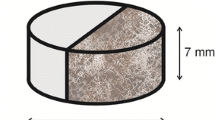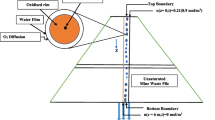Abstract
An extensive array of deep, large diameter wells is required to locally dewater the aquifers in the Rhenish lignite mining district in Germany, some of which are anoxic. The performance of the wells is often influenced by the precipitation of metal hydroxides, such as FeOOH or MnOOH, which causes well clogging. A laboratory study was undertaken to gain a general understanding of the clogging processes and to create a basis for testing and developing techniques that could possibly prevent or reduce the loss of well efficiency. The chemical genesis of Fe-hydroxide incrustations in a well screen section was reproduced in an experimental model under controlled boundary conditions. In the model, the clogging process was accelerated by modifying the pH and Fe concentration relative to the in situ values. The effect of clogging on the hydraulic situation in the gravel material was quantified by measuring the hydraulic head in the section of the annular gravel pack. Increases in the hydraulic gradient up to 75 % were measured. Analysis of the gravel material using a sequential extraction procedure after the experiment yielded Fe contents up to 5.4 g kg−1. According to X-ray diffraction, the incrustations mainly consist of 6 line ferrihydrite and lepidocrocite.
Zusammenfassung
Eine beträchtliche Anzahl tiefer Brunnen von großem Durchmesser ist nötig, um die teilweise anoxischen Grundwasserleiter im Rheinischen Braunkohlenrevier lokal zu entwässern. Die Leistung der Brunnen wird oftmals durch die Ausfällung von Metallhydroxiden wie FeOOH oder MnOOH beeinflusst, welche eine Verockerung der Brunnen verursachen. Die hier vorgestellte Laborstudie soll zum grundsätzlichen Verständnis der Verockerungsprozesse beitragen und eine Grundlage schaffen, um potenzielle Techniken zur Prävention oder Reduktion von Verockerungserscheinungen testen und entwickeln zu können. Die chemische Entstehung von Eisenhydroxidverkrustungen in einem Brunnenabschnitt wurde in einem experimentellen Modell unter kontrollierten Rahmenbedingungen nachgebildet. Im Modell wurde der Verockerungsprozess beschleunigt, indem der pH-Wert und dieFe(II)-Konzentrationen relativ zu den in situ Werten modifiziert wurden. Der Einfluss der Verockerung auf die hydraulischen Verhältnisse im Filterkies wurde über Messungen der hydraulischen Druckhöhe innerhalb des Filterkieses quantifiziert. Der hydraulische Gradient im Filterkies stieg durch die im Verlauf des Versuches fortschreitende Verockerung um bis zu 75 % an. Analysen des Kiesmaterials mittels sequentieller Extraktion nach dem Experiment ergaben Eisengehalte von bis zu 5,4 g kg‑1. Laut röntgendiffraktometrischen Untersuchungen bestehen die Inkrustationen hauptsächlich aus 6L-Ferrihydrit und Lepidokrokit.
Resumen
Una amplia variedad de pozos de gran diámetro y profundidad, es requerida para agotar localmente los acuíferos, algunos de los cuales anóxicos, en el distrito minero de lignito de Renania en Alemania. El comportamiento de los pozos es frecuentemente influido por la precipitación de hidróxidos metálicos como FeOOH o MnOOH, que causa una obstrucción en los pozos. Un estudio de laboratorio fue llevado a cabo para obtener una comprensión general de los procesos de obstrucción y para crear una base para el ensayo y desarrollo de técnicas que podrían posiblemente prevenir o reducir la pérdida de eficiencia de los pozos. La génesis química de las incrustaciones de hidróxidos de Fe en una sección del pozo fue reproducida en un modelo experimental bajo condiciones límite controladas. En el modelo, el proceso de obstrucción fue acelerado modificando el pH y la concentración de Fe relativos a los valores in situ. El efecto de obstrucción en la situación hidráulica en la grava fue cuantificado midiendo la cabeza hidrostática en la sección de la grava anular. Fueron medidos incrementos en el gradiente hidráulico de hasta el 75%. El análisis de la grava usando un procedimiento de extracción secuencial después del experimento mostró contenidos de Fe de hasta 5,4 g kg_1. De acuerdo a la difracción de rayos X, las incrustaciones consistieron principalmente de ferrihidrita de seis líneas y lepidocrocita.
抽象
在德国莱茵褐煤矿区有一大批大口径深井,用以对含水层进行局部疏水,其中一些 疏水井处于缺氧状态。通常随着含FeOOH, MnOOH等金属氢氧化物沉淀造成的井壁堵 塞,疏水井的疏水效率遭到降低。 通过本文实验可以深入了解井壁的堵塞机理, 也为阻止或降低疏水井效率的损失提供了实验基础和发展依据。在可控边界条件 下,本文实验模拟了在疏水井过滤段铁 的氢氧化物的化学结壳过程。根据现场资 料调整pH值和铁离子浓度可以加速该模型的结壳反应。通过测量环形填砾段的水头 可以定量评价化学堵塞对水力 性质的影响。实验测得,填砾段水力梯度增加75%。 通过对模拟实验后的填砾段材料进行循序提取分析,测得含铁量达5.4g/kg。X光衍 射结果表 明硬壳的主要成分是六方针铁矿和纤铁矿。









Similar content being viewed by others
References
Bergmann J, Friedel P, Kleeberg R (1998) BGMN—a new fundamental parameters based Rietveld program for laboratory X-ray sources, its use in quantitative analysis and structure investigations. CPD Newsletter 20:5–8, http://lachlan.bluehaze.com.au/cpdnews98/art05.htm
Childs CW (1992) Ferrihydrite: a review of structure, properties and occurrence in relation to soils. Z Pflanzenernähr Bodenk 155:441–448. doi:10.1002/jpln.19921550515
Cornell RM, Schwertmann U (2003) The iron oxides: structure, properties, reactions, occurences and uses. ISBN 978–3527302741. Wiley-VCH, Weinheim
Davison W, Seed G (1983) The kinetics of the oxidation of ferrous iron in synthetic and natural waters. Geochim Cosmochim Acta 47:67–79. doi:10.1016/0016-7037(83)90091-1
German Institute for Standardization (1983) DIN 38406–1: Deutsche Einheitsverfahren zur Wasser-, Abwasser- und Schlammuntersuchung—Kationen (Gruppe E)—Bestimmung von Eisen (E 1). Beuth, Berlin
German Institute for Standardization (2001) DIN 21919–3: Bergmännisches Risswerk—Stratigraphie—Teil 3: Regionale und lokale Gliederungen Braunkohle. Beuth, Berlin
Hässelbarth U, Lüdemann D (1967) Die biologische Verockerung von Brunnen durch Massenentwicklung von Eisen- und Manganbakterien. BBR 18:363–368, 401–406
Henkel S, Weidner C, Roger S, Schüttrumpf H, Rüde TR, Klauder W, Vinzelberg G (2012) Untersuchung der Verockerungsneigung von Vertikalfilterbrunnen im Modellversuch (Investigation of the clogging affinity of vertical wells using an experimental model). Grundwasser doi: 10.1007/s00767-012-0198-9
Holluta J, Kölle W (1964) Über die Oxydation von zweiwertigem Eisen durch Luftsauerstoff. GWF 105(18):471–474
Houben GJ (2003) Iron oxide incrustations in wells. Part 1: genesis, mineralogy and geochemistry. Appl Geochem 18:927–939. doi:10.1016/S0883-2927(02)00242-1
Houben GJ, Treskatis C (2007) Water well rehabilitation and reconstruction. ISBN 978–0071486514. McGraw-Hill, New York City
Klauder W (2011) Experimental study of flow to vertical groundwater wells. Dissertation, RWTH Aachen University, Germany, http://darwin.bth.rwth-aachen.de/opus3/volltexte/2011/3570/
Ralph DE, Stevenson JM (1995) The role of bacteria in well clogging. Wat Res 29(1):365–369. doi:10.1016/0043-1354(94)E0077-J
Refait P, Génin J-MR (1993) Mechanisms of formation and structure of green rust one in aqueous corrosion of iron in the presence of chloride ions. Corros Sci 40(9):1547–1560. doi:10.1016/S0010-938X(98)00066-3
Rinck-Pfeiffer S, Ragusa S, Sztajnbok P, Vandevelde T (2000) Interrelationships between biological, chemical, and physical processes as an analog to clogging in aquifer storage and recovery (ASR) wells. Wat Res 34(7):2110–2118. doi:10.1016/S0043-1354(99)00356-5
Rüde TR, Banning A, Klauder W, Roger S, Vinzelberg G (2010) Improving the effectiveness of wells for lignite mine dewatering. In: Wolkersdorfer C, Freund A (eds) Mine Water and Innovative Thinking. ISBN 978-1-897009-47-5. CBU Press, Sydney, Nova Scotia, Canada, p 89–93
RWE Power AG (2008) Bericht zur Grundwasserbeschaffenheit—Vorfeld. Bericht 2.4, unpublished
Schneider H, Thiele S (1965) Geohydrologie des Erftgebietes. Ministerium für Ernährung, Landwirtschaft und Forsten des Landes Nordrhein-Westfalen, Aachen
Walter R (2010) Aachen und nördliche Umgebung. Sammlung Geologischer Führer Band 101. ISBN 978-3-443-15087-7 Gebr. Borntraeger, Stuttgart, Germany
Weidner C, Henkel S, Lorke S, Rüde TR, Schüttrumpf H, Klauder W (2011) Investigation of clogging processes on vertical filter wells using an experimental model. In: Rüde TR, Freund A, Wolkersdorfer C (eds) Mine Water—Managing the Challenges. ISBN 978-3-00-035543-1. Comouth, Aachen, p 79–83
Wenzel WW, Kirchbaumer N, Prohaska T, Stingeder G, Lombi E, Adriano DC (2001) Arsenic fractionation in soils using an improved sequential extraction procedure. Anal Chim Acta 436(2):309–323. doi:10.1016/S0003-2670(01)00924-2
Acknowledgments
The authors thank Christian Forkel and Wilhelm Schlegel (RWE Power AG) for their cooperation and for creating the unique opportunity to take samples in the open pits. We also thank RWE Power AG for its contribution to the project’s funding. Andre Banning (RWTH Aachen University) is acknowledged for his help in analytical and technical questions. Furthermore, we appreciate the inspiring correspondence with Christoph Treskatis (Bieske und Partner Beratende Ingenieure GmbH). Michel Heuser from the Institute of Clay and Interface Mineralogy (CIM) of RWTH Aachen University is acknowledged for allocating the extensive CIM database of structure files and for his assistance in handling the BGMN software. The authors thank Sabine Heim and Katharina Wohlfart of the Institute of Geology and Geochemistry of Petroleum and Coal (LEK) of RWTH Aachen University for their help in sample preparation and for measuring the TOC. David Rubinos from the Departamento de Edafoloxía e Química Agrícola, Facultade de Farmacia, Universidade de Santiago de Compostela and Hui Hu from the Department of Engineering Geology and Hydrogeology (LIH) of RWTH Aachen University are acknowledged for their asistance with the Spanish and Chinese Abstract.
Author information
Authors and Affiliations
Corresponding author
Rights and permissions
About this article
Cite this article
Weidner, C., Henkel, S., Lorke, S. et al. Experimental Modelling of Chemical Clogging Processes in Dewatering Wells. Mine Water Environ 31, 242–251 (2012). https://doi.org/10.1007/s10230-012-0188-2
Received:
Accepted:
Published:
Issue Date:
DOI: https://doi.org/10.1007/s10230-012-0188-2




